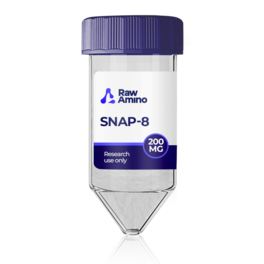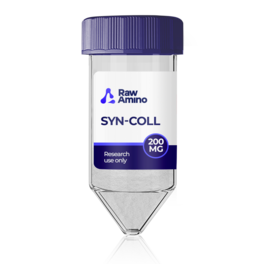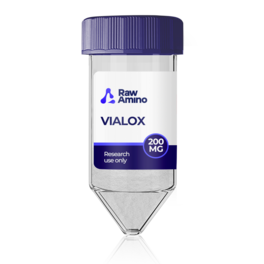
Syn-AKE – 200MG
$212.00
Discount per Quantity
| Quantity | Discount | Price |
|---|---|---|
| 5 - 8 | 5% | $201.40 |
| 9 + | 10% | $190.80 |
Scientific Overview of Syn-AKE
Syn-AKE is a synthetic peptide developed to replicate certain properties of Waglerin-1, a naturally occurring peptide originally identified in snake venom. Waglerin-1 is recognized for its interaction with neuromuscular signaling, particularly through its influence on acetylcholine transmission. In creating Syn-AKE, researchers aimed to construct a smaller, selective analogue capable of mimicking aspects of Waglerin-1’s mechanism in a controlled research setting. Interest in this compound has centered on its potential to interfere with muscular communication pathways, specifically at the neuromuscular junction.
Alternative Names: Tripeptide-3, Dipeptide Diaminobutyroyl Benzyl Amide Diacetate
Syn-AKE Studies and Research Data
Syn-AKE Insights into Neuromuscular Signaling
Research suggests Syn-AKE may act as a competitive antagonist at nicotinic acetylcholine receptors. In this context, it appears to occupy binding sites that acetylcholine would normally activate, thereby potentially reducing the signaling impulses between nerves and muscles. Studies propose that this action may temporarily alter contractile responses, producing reduced muscular activity during experimental observation. Notably, unlike Waglerin-1, Syn-AKE appears to display greater selectivity, avoiding activity at receptors outside the neuromuscular junction such as those involving gamma-aminobutyric acid (GABA).
Syn-AKE Explorations of Surface Structure and Appearance
Several investigations have examined Syn-AKE in relation to surface topography of the skin. In certain controlled models, the peptide has been associated with reductions in visible creasing and depth of wrinkles. Some reports describe both immediate observations of smoother surface appearance and sustained findings over extended evaluation periods, including improvements noted at one month and three months of continued use in test settings. Data have suggested potential reductions in the visibility of lines by up to half, though these findings remain preliminary and subject to ongoing inquiry.
Comparative Evaluation Among Peptides
Syn-AKE has also been studied alongside other peptides developed for cosmetic and biomedical research. Results indicate it may produce more pronounced outcomes across multiple measures compared to other analogues tested under similar conditions. Some experiments suggest that regular exposure to Syn-AKE may amplify its observed research outcomes over time, with incremental improvements in modeled wrinkle reduction. These comparative assessments have positioned Syn-AKE as a candidate of interest for further exploration into neuromuscular and dermal peptide activity.
Conclusion
Syn-AKE is a synthetic analogue inspired by Waglerin-1 and designed for the study of neuromuscular signaling and dermal modeling. Research has highlighted its potential to competitively interact with acetylcholine receptors, influence muscular signaling, and alter skin surface features in experimental systems. While findings remain preliminary, Syn-AKE continues to serve as a tool for ongoing investigation into peptides with potential structural and signaling relevance.
References
- Pai, V. V., Bhandari, P., & Shukla, P. (2017). “Topical peptides as cosmeceuticals.” Indian Journal of Dermatology, Venereology and Leprology, 83, 9.
- Balaev, A. N., K. A. Okhmanovich, and V. N. Osipov. “A shortened, protecting group free, synthesis of the anti-wrinkle venom analogue Syn-Ake® exploiting an optimized Hofmann-type rearrangement.” Tetrahedron Letters 55.42 (2014): 5745-5747.
- Reddy, B., Jow, T., & Hantash, B. M. (2012). “Bioactive oligopeptides in dermatology: Part I.” Experimental Dermatology 21(8), 563–568.
- Zhmak, Maxim Nurgayanovich, et al. “Peptide inhibitors of nicotinic acetylcholine receptor.” U.S. Patent No. 9,550,808. 24 Jan. 2017.
- Trookman, Nathan S., et al. “Immediate and long-term clinical benefits of a treatment for facial lines and wrinkles.” The Journal of Clinical and Aesthetic Dermatology 2.3 (2009): 38.
- Munawar A, Ali SA, Akrem A, Betzel C. “Snake Venom Peptides: Tools of Biodiscovery.” Toxins (Basel). 2018;10(11):474.
- Chhipa, Nadim MR, and B. Chaudhari. “Toxin as a Medicine.” Journal of Current Pharmaceutical Research 9.1 (2012): 11-8.
Disclaimer:
The products mentioned are intended solely for laboratory research and in-vitro experimentation. They are not approved for human or animal use of any kind. All details provided are for educational purposes only. By purchasing from this site, you agree to comply with our Terms and Conditions.
Only logged in customers may leave a review.





Reviews
There are no reviews yet.